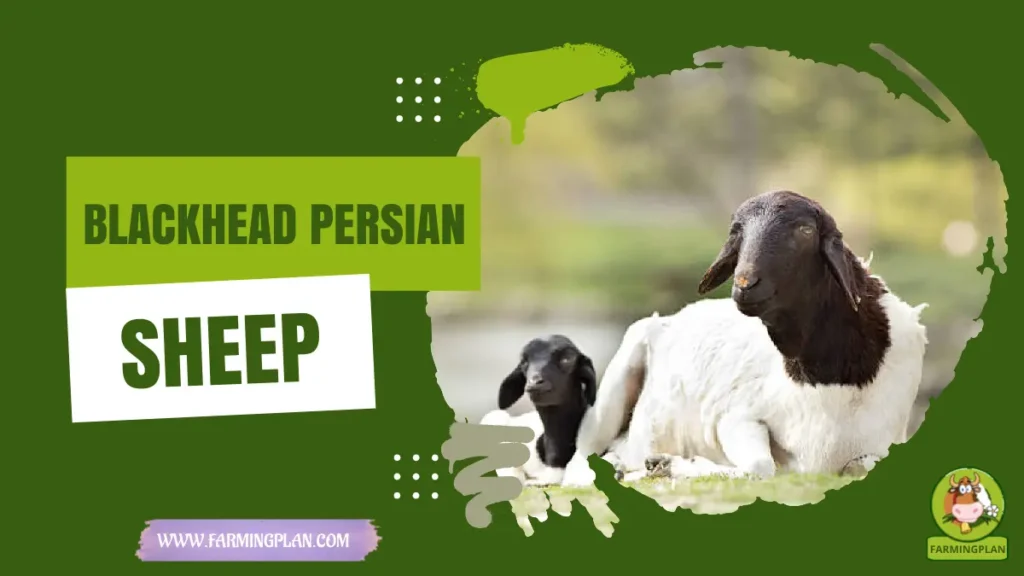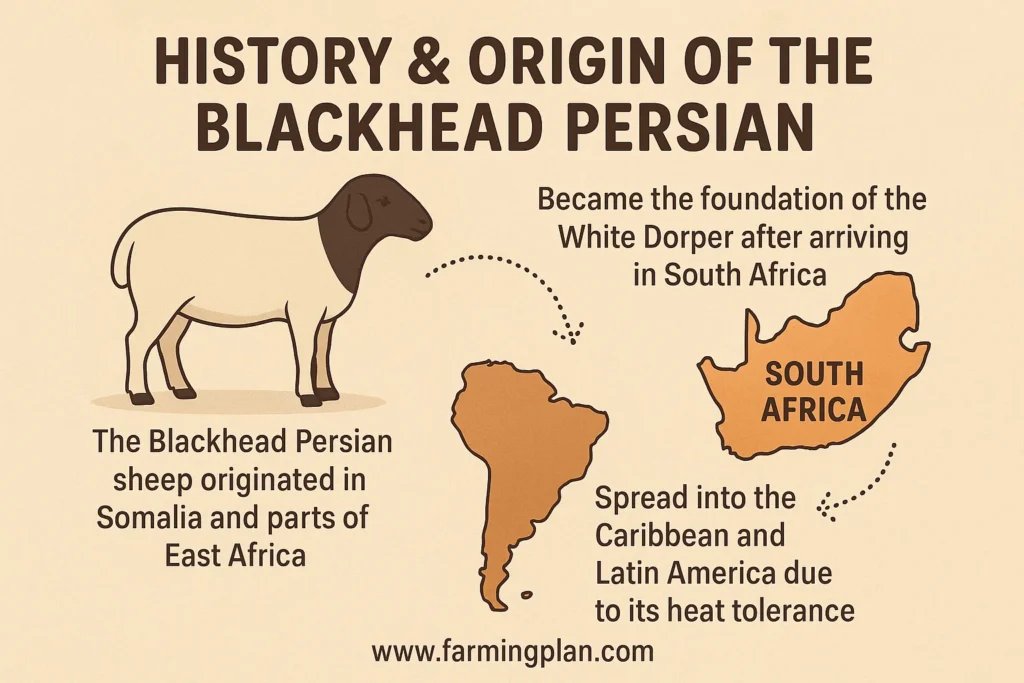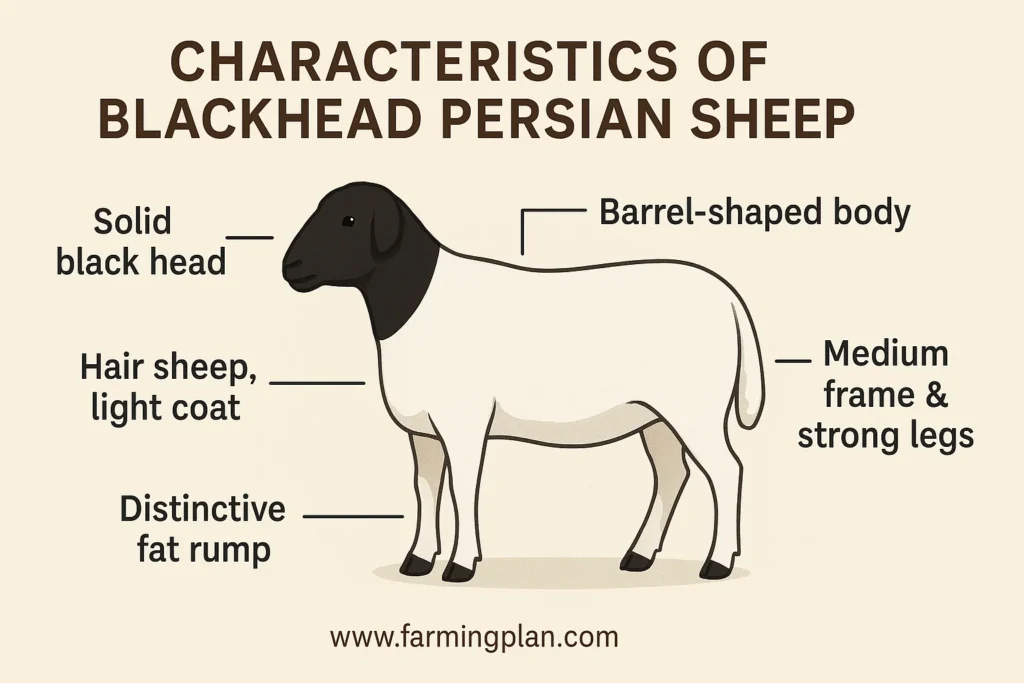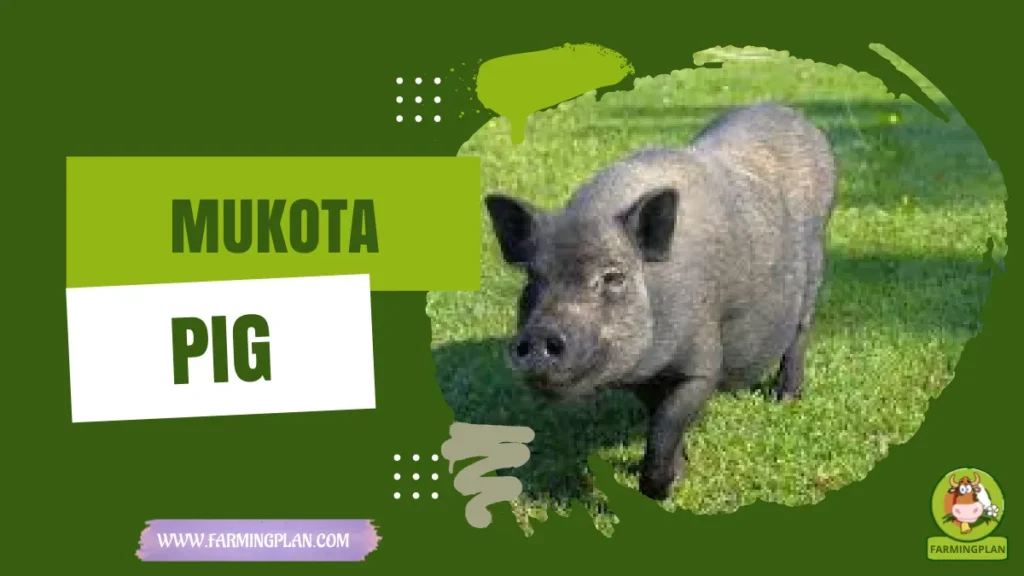Meet the Blackhead Persian Sheep, a unique breed that’s tough, productive, and easy to care for. With its striking black head and classic white body, this sheep stands out in any flock. Originating from East Africa and now found worldwide, the Blackhead Persian is a fat-rumped, hair-coated breed that thrives in hot, dry climates. In this article, I’ll share everything I’ve learned from working with these remarkable animals—what they eat, how they behave, how to care for them, and why they’re a top choice for meat and breeding programs. Whether you’re a hobbyist, a small-scale farmer, or running a full-fledged flock, you’ll find this guide packed with practical tips and real-world advice.

History & Origin of the Blackhead Persian
The Blackhead Persian sheep didn’t just wander onto the scene—they come with a legacy. These sheep trace their roots back to Somalia and parts of East Africa. Farmers in these arid lands needed a breed that could handle the heat, forage on scrubby terrain, and still grow fast enough to bring in meat value. The Blackhead Persian ticked all those boxes.

When the breed made its way to South Africa, it quickly became a hit. Breeders in the region used it as the foundation to develop the White Dorper—a cross between the Blackhead Persian and the Dorset Horn. Thanks to that fat rump and heat tolerance, the Blackhead Persian spread into the Caribbean and parts of Latin America, thriving in hot zones where other breeds needed pampering. It’s a story of resilience, really—one that’s kept this breed in the spotlight for generations.
Read More: Assaf Sheep: How To Start Profitable Farming
Characteristics of Blackhead Persian Sheep
Let me paint you a picture: imagine a white sheep with a solid black head, a barrel-shaped body, and a distinctive fat rump—that’s the Blackhead Persian. These sheep aren’t built like your average wooly fluffballs. Instead, they’re hair sheep, which means no shearing and much less maintenance. Their light coat helps them handle the heat without breaking a sweat (literally).

They usually have a medium frame with strong legs and a solid structure. Their body is built for meat, and you’ll see that in the fast weight gains they offer. Don’t expect much in the way of wool—there’s just a light covering of hair, sometimes with a bit of fuzz. This makes them especially popular among breeders in dry climates who don’t want the hassle of wool care. It’s that combination of proper body condition, proportion, and low-maintenance appeal that makes this breed so unique.
Read More: Southdown Sheep: Smallest British Breed
Temperament & Behavior of Blackhead Persian Sheep
Blackhead Persians aren’t just pretty faces—they’ve got the kind of temperament that makes life easy for folks like me. These sheep are calm, sociable, and adapt quickly to new environments. I’ve found they do well in flocks, whether you’re raising them for meat or breeding. They don’t spook easily, and their docile nature makes them ideal even for beginner farmers.

But what really stands out? The mothers. These ewes are incredible at raising lambs. They’ve got strong maternal instincts, rarely reject lambs, and generally keep their babies safe and well-fed. That’s a big reason why lamb survival rates tend to be high in this breed. If you’ve worked with fussier breeds, you’ll appreciate the “set-it-and-forget-it” style of these easy-care animals.
Read More: Arabi Sheep: How To Start Your Farm
Diet & Feeding
Feeding Blackhead Persian sheep is pretty straightforward. In my experience, they’re efficient foragers who do well on native grasses, shrubs, and even cactus when food gets scarce. Their fat rump stores energy, making them ideal for drought-prone areas. That said, to get the best carcass characteristics, I always balance their diet with some protein-rich supplements like legumes or pellets during growth or breeding phases.
One thing you don’t want to skimp on is minerals—especially salt blocks and calcium. These help with bone development and reproduction. Fresh water is non-negotiable. And when lambing season rolls around, I make sure my ewes are getting extra nutrition to support both milk production and body recovery. They don’t need a gourmet diet—but a consistent, balanced one goes a long way.
Uses & Purpose
When folks ask me why I keep Blackhead Persians, I tell them it’s all about the meat. These sheep are champion meat producers. Their quick growth, high muscle-to-bone ratio, and fat reserves make them ideal for the butcher market. Farmers in arid regions especially love them because they don’t need lush pastures to thrive.
Besides meat, they’re also used in breeding programs—like the creation of the White Dorper. Their genetics bring in traits like hardiness, easy birthing, and high fertility. Some farmers keep them as part of a complementary flock, using them to cross with other breeds and boost resilience and growth rates. Whether you’re selling lamb or building a better breed, they’ve got a purpose on just about any farm.
Special Traits & Unique Strengths
Now, not all sheep are created equal, and the Blackhead Persian proves that every time. One of their most unique features is the fat rump—it’s like a natural energy pack. This allows the sheep to survive and reproduce even when the forage gets thin. That’s a lifesaver in the dry season.
Another standout trait is their adaptability. These sheep don’t just survive—they thrive in hot, dry regions where other breeds might struggle. Plus, their hair coat means no wool maintenance, no shearing, and fewer issues with external parasites. They’re also known for excellent foraging, strong mothering instincts, and consistent weight gain. In short, they’re a low-maintenance, high-reward kind of breed.
Common Health Issues & How to Prevent Them
Blackhead Persians are pretty hardy, but like all animals, they’re not immune to trouble. In my flock, the most common issues are internal parasites and foot rot—especially during the rainy season. Regular deworming and keeping their hooves trimmed makes a world of difference.
Heat stress is another concern, especially during peak summer. I always make sure there’s plenty of shade and access to cool water. Vaccinations are essential too—especially for clostridial diseases. Keep an eye on body condition, appetite, and coat quality. A healthy sheep is active, alert, and growing. If something feels off, trust your gut and call the vet.
Great Care And Patience Turn Blackhead Persian Sheep Into Thriving Flocks That Reward You With Quality Meat And Joy.
Step-by-Step Farming Guide: Raising Blackhead Persian Sheep
Raising Blackhead Persian sheep can be incredibly rewarding, especially once you get the hang of their care and needs. To make it easier, I’ve put together a simple, step-by-step guide that walks you through everything—from choosing your stock to managing their health and feeding. Whether you’re a newbie or looking to improve your flock, these practical steps will help you raise healthy, thriving sheep with confidence.
Step 1: Choosing Your Blackhead Persian Sheep
The first thing you want to do is pick healthy, strong animals for your flock. Look for sheep with a clean, black head and a white body—the classic Blackhead Persian look. They should have good body condition and be free from any visible wounds or parasites. It’s best to buy from a reputable breeder who knows the breed well, especially if you’re new to raising this type of sheep. I always check their maternal lineage too, since these sheep are known for being excellent mothers, which really helps your flock grow steadily.
Step 2: Setting Up Their Living Space
Blackhead Persian sheep do well in arid and semi-arid regions, but they still need a comfortable shelter to protect them from harsh weather, especially during lambing season. Make sure the pen is dry, clean, and well-ventilated. I recommend using natural materials like wood or shade nets to keep the shelter cool, since these sheep thrive in warm climates but don’t like extreme heat. Also, provide enough space—about 15 square feet per sheep—to avoid overcrowding and stress.
Step 3: Feeding and Nutrition
Feeding is super important for the growth and health of your Blackhead Persian sheep. These sheep are hardy and good foragers, but you still need to offer them a balanced diet. Provide plenty of fresh pasture or hay, along with a mix of grains to support fast growth rates and meat production. I always include minerals and salt blocks to keep them healthy. Avoid overfeeding grains, as it can cause digestive problems. Fresh water must be available at all times — hydration is key, especially in hot regions.
Step 4: Breeding and Lambing
Blackhead Persian sheep have an impressive maternal instinct, and their lambing percentages are pretty high. When planning your breeding, ensure your ewes are healthy and in good body condition to support pregnancy. I usually separate pregnant ewes about a month before lambing to give them a calm environment. During lambing, keep an eye out for any complications but trust that these sheep are generally easy lambers. After birth, help the lambs get their first feed of colostrum—it’s vital for their immune system.
Step 5: Health Care and Disease Prevention
Like any livestock, Blackhead Persian sheep need regular health checks. I recommend vaccinating them against common sheep diseases and keeping an eye out for parasites, especially ticks and worms. Regular deworming and good pasture management help keep your flock healthy. If you notice any signs of illness—like loss of appetite, coughing, or limping—consult your vet right away. Good hygiene, clean water, and proper nutrition go a long way in preventing disease.
Step 6: Managing Your Flock
Once your sheep are settled, managing their daily care is key to success. I check on my flock at least twice a day to ensure they have food, water, and no injuries. Rotating grazing areas helps prevent overgrazing and reduces parasite risks. Keep records of births, weights, and any health treatments—it helps track progress and plan future breeding. Blackhead Persians are fast-growing, so monitoring their weight gain will help you decide the best time for market or breeding.
Expert Tips & Best Practices
- Always track growth rates and adjust the diet accordingly for optimal gains.
- Never overcrowd your flock—more space equals fewer problems.
- Rotate pastures every few weeks to control parasites.
- Use cactus in the dry season—it’s cheap and nutritious.
- Keep good records—it’ll save you headaches during breeding or sales.
FAQ
What are Blackhead Persian Sheep good for?
They’re ideal for meat production, especially in hot, dry climates, thanks to their fat rump and fast growth.
Do Blackhead Persian Sheep grow wool?
No, they’re hair sheep with a short coat. You don’t need to shear them.
Are they good for beginners?
Absolutely. They’re low-maintenance, calm, and easy to manage.
Where can I buy Blackhead Persian Sheep?
Look for breeders online by searching blackhead persian sheep for sale or check local livestock auctions.
How much space do they need?
About 10–15 square feet per adult in housing, with a good amount of grazing pasture outside.
Conclusion
If you’re raising sheep in warm, dry regions and want something that grows fast, takes care of its lambs, and doesn’t give you a ton of trouble—go for the Blackhead Persian. From their black heads and white bodies to their fat rumps and easy-care coats, these sheep have proven their worth across generations. Whether you’re new to sheep or building a breeding program, this breed offers performance, personality, and profit.


